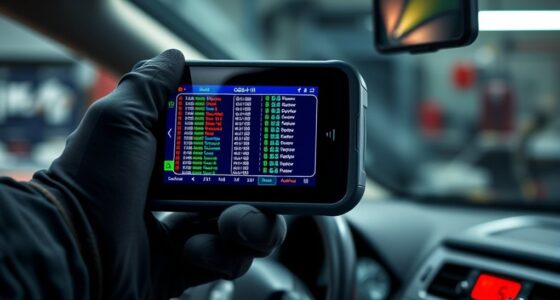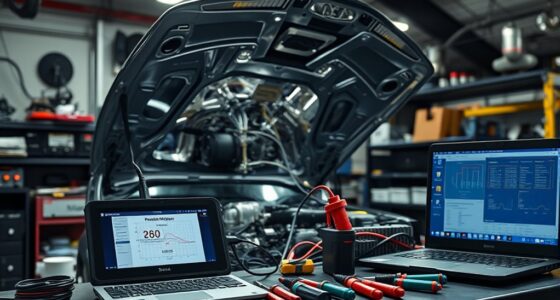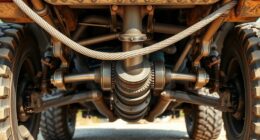To use freeze frame data effectively, focus on the parameters recorded when the fault occurs, like RPM, fuel trim, and sensor readings. Compare these values to normal ranges and look for patterns or anomalies that match specific issues. Use this data along with diagnostic codes to guide inspections and repairs, helping you target the root cause efficiently. Keep analyzing and cross-referencing to improve your troubleshooting skills as you explore more insights.
Key Takeaways
- Familiarize yourself with common parameters like RPM, coolant temp, and fuel trims to interpret the data accurately.
- Use freeze frame data alongside fault codes to pinpoint specific issues and guide targeted inspections.
- Consider the vehicle’s condition during the fault (e.g., idle, acceleration) to better understand the recorded parameters.
- Correlate abnormal readings with potential component problems for efficient troubleshooting and repair.
- Verify repairs by checking if parameters return to normal, and document findings to improve future diagnostics.

Freeze frame data can be be a powerful tool for diagnosing vehicle issues, but only if you know how to interpret it correctly. When your check engine light comes on, the data stored at that moment provides a snapshot of the vehicle’s operating conditions. This snapshot captures various parameters like engine RPM, throttle position, coolant temperature, and more, all of which are vital for effective troubleshooting. To leverage this information, you need to develop solid diagnostic techniques that help you pinpoint the root cause of the problem quickly.
Freeze frame data offers crucial insights into vehicle issues when interpreted correctly.
First, familiarize yourself with the typical parameters recorded in freeze frame data. Understanding what each value represents enables you to identify abnormal readings that may indicate specific issues. For example, if the data shows high engine temperature along with a certain fault code, you can focus your troubleshooting strategies on cooling system components rather than wasting time on unrelated parts. The key is to look for patterns or anomalies that stand out from normal operating ranges, which often reveal the underlying problem.
Next, combine freeze frame data with your diagnostic techniques. Use the recorded parameters to guide your inspection process. For instance, if the data reveals a rich fuel mixture during a misfire, you might check the fuel injectors, sensors, or fuel pressure regulator. If the data shows a lean condition, focus on vacuum leaks or intake issues. This targeted approach saves you time and reduces guesswork, making your troubleshooting more efficient and accurate. Remember, freeze frame data isn’t just a static record; it’s a guide that, when interpreted correctly, can direct your diagnostic efforts precisely where they’re needed.
Furthermore, consider the context of the recorded data. Look at the conditions under which the fault occurred—was the vehicle accelerating, idling, or cruising? This context can clarify whether the fault is a transient issue or a persistent problem. Incorporating this perspective into your troubleshooting strategies helps you reproduce the fault if necessary and verify your repairs afterwards. Always document the data you find and the steps you take, creating a logical trail that improves your diagnostic process over time. Additionally, understanding vetted diagnostic techniques ensures you’re using reliable methods to interpret the data accurately.
Frequently Asked Questions
How Can Freeze Frame Data Improve Vehicle Diagnostics?
Freeze frame data enhances vehicle diagnostics by providing detailed snapshots of sensor calibration at the moment a fault occurs. You can interpret fault codes more accurately, identifying specific conditions that caused the issue. By analyzing this data, you gain insights into the vehicle’s behavior, enabling you to pinpoint problems quickly. This targeted approach saves time, ensures precise repairs, and helps prevent future malfunctions.
What Tools Are Best for Analyzing Freeze Frame Data?
You should use diagnostic software like OBD-II scanners with built-in data visualization features to analyze freeze frame data effectively. These tools help you interpret complex information quickly by presenting data visually, making it easier to identify issues. Look for software that offers real-time analysis and detailed reports, so you can pinpoint problems accurately and efficiently, saving time and improving your vehicle diagnostics process.
Can Freeze Frame Data Predict Future Vehicle Failures?
Freeze frame data can’t directly predict future vehicle failures, but it plays a crucial role in failure forecasting. In fact, predictive maintenance programs that analyze freeze frame snapshots can identify patterns indicating potential issues. For example, studies show that vehicles monitored with these techniques have a 30% lower breakdown rate. You can use this data to schedule repairs proactively, preventing costly failures and extending your vehicle’s lifespan.
How Often Should Freeze Frame Data Be Reviewed?
You should review freeze frame data regularly, ideally during timing updates or when monitoring driver behavior. Frequent reviews help you catch patterns or anomalies early, ensuring timely maintenance and improving safety. Incorporate reviews after any significant driving event or periodically, such as monthly or quarterly. Staying consistent enables you to identify issues promptly, optimize vehicle performance, and maintain accurate records for future analysis.
Is Freeze Frame Data Useful for Emissions Testing?
Yes, freeze frame data is useful for emissions testing because it helps you identify sensor accuracy issues and pinpoint specific conditions when emissions exceed limits. By integrating this data with other diagnostic information, you can better understand the cause of emissions failures. Regularly reviewing freeze frame data allows you to verify sensor performance and guarantee your vehicle’s emissions system operates efficiently, helping you pass testing smoothly.
Conclusion
So, next time you’re staring at a freeze frame, don’t just shrug and move on. Embrace the chaos, decode those tiny details, and turn that snapshot into your secret weapon. After all, who needs a crystal ball when you’ve got freeze frame data? It’s the ultimate game-changer—if you’re brave enough to read between the lines. Remember, in the world of data, a snapshot today keeps the mysteries away… or so they say.







